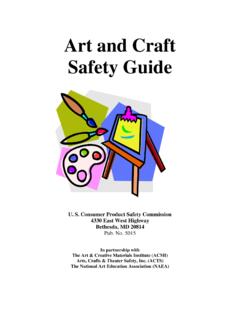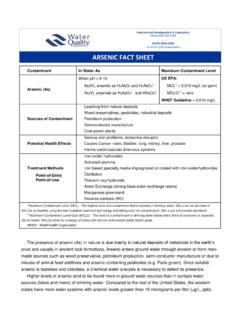Transcription of Vessel Safety Manual - US EPA
1 ~<t)'1'fJJ8t .. ~ ( &"l environmental protection agency ~AI( PR(f(i--:1'+ Vessel Safety Manual OFFICE OF ADMINISTRATION AND RESOURCES MANAGEMENT Safety . HEALTH AND environmental MANAGEMENT DIVISION WASHINGTON, DC APRIL 2012 FOREWORD This Manual sets forth minimum acceptable)))
2 Requirements for the Safety and occupational health of all individuals (crew, scientific staff and passengers) who embark on environmental protection agency (EPA) vessels of any size. EPA vessels currently range in size from the Ocean Survey Vessel Bold (224 feet) and Great Lakes Research Vessel Lake Guardian (180 feet), down to 14-foot aluminum skiffs powered by small outboard engines, canoes and inflatables. Accordingly, this Manual addresses the entire spectrum of EPA Vessel sizes, powered and unpowered. EPA vessels may be operated under contract or charter, by professionally qualified EPA crew, or, in the case of small craft, by EPA scientific staff on an intermittent basis.
3 To achieve the EPA goal of minimizing risk to anyone who embarks on an EPA Vessel , all concerned shall read and understand the requirements of this Manual . EPA vessels are public vessels of the United States. It is EPA s intent to maintain compliance with those existing standards and codes of marine Safety (which appear in Title 46 of the Code of Federal Regulations) deemed necessary to achieve the EPA risk management objective. To that end, this Manual sets forth the minimum requirements that must be met to attain EPA s marine health and Safety objectives.
4 All aspects of good marine practice cannot be set forth in statutes, regulations or standards. Accordingly, the absence of a written requirement for a specific issue should not be interpreted as meaning that the issue has a lower importance or priority. Vessel captains/masters and operators of small craft should emphasize to all personnel that health and Safety are considered to be paramount at all times onboard EPA vessels. EPA Class C vessels contractor crews are subject to the Safety of Life at Sea International Safety Management Code.
5 This Manual provides the top-tier policy for implementing this code requirement. In addition to Safety requirements, this Manual also includes general security requirements for all EPA vessels. The EPA's Safety , Health and environmental Management Division welcomes any suggestions for improving this Manual . Please contact us at to provide your feedback. Revision dated April 2012 i TABLE OF CONTENTS 1.
6 1-1 Scope and Policy .. 1-1 Background and Authority .. 1-1 Program 1-1 EPA Auditing and Self-Assessment 1-2 environmental Management System (EMS) and Stewardship .. 1-2 Principles of a Safety and Health Management System (SHMS) .. 1-3 Changes .. 1-3 2. PROGRAM 2-1 Goals and Objectives .. 2-1 Roles and 2-1 3. CLASSES OF EPA VESSELS .. 3-1 Background .. 3-1 Vessel 3-1 Vessel 3-5 4. LAWS AND 4-1 Involved Organizations .. 4-1 5. MANNING .. 5-1 Background.
7 5-1 Licensed Personnel .. 5-1 Makeup of Crew .. 5-1 Scientific Personnel Limitations All EPA Class 5-2 Captain/Master of the 5-3 Chief 5-3 Vessel Organization Class C 5-3 6. GENERAL MARINE ENGINEERING AND ONBOARD Safety REQUIREMENTS .. 6-1 Background .. 6-1 Standards .. 6-1 Marine Engineering 6-2 Exhaust Uptake and Vent Control .. 6-2 Electrical Engineering Details .. 6-3 Structural Standards and 6-3 Stability .. 6-4 Ground Tackle .. 6-5 Inspection .. 6-5 Oxygen and Acetylene Cylinders.
8 6-5 Scientific 6-7 Watertight 6-8 Revision dated April 2012 ii Onboard Safety 6-10 7. FIRE 7-1 Applicability .. 7-1 7-1 Firefighting Responsibilities .. 7-1 Fire Control Plans .. 7-7 Quality 7-7 General Fire Prevention Training .. 7-10 Marking of Fire protection Equipment.
9 7-11 Control of Ignition Sources and Combustible 7-12 Life Safety Considerations .. 7-17 Structural Fire protection .. 7-18 Fire-Extinguishing 7-19 Precautions for Flooded Space Fire Suppression 7-22 Fire Detection and Alarm Systems .. 7-23 8. MEDICAL AND FIRST 8-1 8-1 Specific Requirements .. 8-1 9. LIFESAVING AND Safety , COMMUNICATIONS AND POLLUTION CONTROL 9-1 Life Saving and Safety Equipment .. 9-1 Communications Equipment .. 9-14 Pollution Control 9-19 10. Vessel OPERATIONS, RECORDS, REPORTS, AND EMERGENCY 10-1 Introduction.
10 10-1 Station Bills .. 10-1 Log Books .. 10-1 Cruise and Float 10-1 Reporting All EPA Class Vessels .. 10-2 Weather Reports .. 10-3 Emergency Crisis and Accident Reporting 10-3 11. SOLAS INTERNATIONAL Safety MANAGEMENT (ISM) 11-1 Background .. 11-1 Applicability .. 11-1 Safety Management System .. 11-1 ISM Safety Management Systems Certification and Enforcement .. 11-2 12. HEAVY 12-1 12-1 EPA Class A Vessel Weather Restriction .. 12-1 Safety Precautions During Heavy Weather 12-1 Revision dated April 2012 iii 13.
















